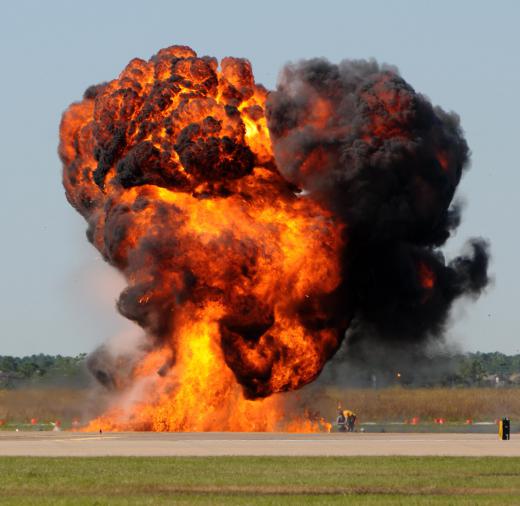What are the Largest Non-Nuclear Explosions in History?
 Michael Anissimov
Michael Anissimov
Since the invention of high explosives, there have been numerous powerful non-nuclear explosions which have killed or injured upwards of 1,000 people at a time. Because measuring the exact magnitude of an explosion is impossible without careful measurements, and most large non-nuclear explosions are in fact accidental, it is impossible to say which of these explosions is the largest. Often, the amount of explosives detonated is known, but the size of an explosion cannot be directly calculated from the weight of the explosives alone, so an accurate ranking scheme is impossible.
There are five major non-nuclear explosions that many agree are among the largest, if not the largest:
- The Halifax explosion (1917, estimated equivalent 2.9 kilotons (kt) of TNT)
- The Texas City disaster (1947, 2 - 4 kt)
- The "British Bang" military test on Heligoland in the North Sea (1947, 4 kt)
- The Minor Scale military test in New Mexico (1985, 4 kt)
- The Port Chicago disaster (1944, 5 kt)

The Halifax explosion, which occurred on 6 December 1917, in Halifax, Nova Scotia, Canada, resulted from the collision of a French cargo ship carrying 5.8 million pounds (2,653 tonnes) of explosives with a Norwegian ship. The ship was fully loaded, carrying explosives for shipment to Europe for use during World War I. The resulting non-nuclear explosion was about a third the strength of the atomic bomb dropped on Hiroshima. About 2,000 people, mostly Canadians, died, and 9,000 were injured. The entire harbor was destroyed.

The "British Bang" and Minor Scale non-nuclear explosions were military tests, both designed to simulate nuclear explosions. Both involved several thousand tonnes of explosives, and had a magnitude similar to the Halifax explosion, but no one was hurt. The British Bang was carried out on the island of Heligoland, while Minor Scale was conducted at the White Sands Missile Range in New Mexico. During Minor Scale, 9.6 million pounds (4,350 tonnes) of high explosive was detonated.
Both the Texas City disaster and the Port Chicago disaster were tragic repeats of the same general formula as the Halifax disaster. Fully loaded ships exploded while in port, killing several hundred people in both incidents. Although these non-nuclear explosions may have seemed very extreme to those caught in the blast, they are very small in comparison to the explosions produced by modern nuclear weapons.
AS FEATURED ON:
AS FEATURED ON:












Discussion Comments
About 4,000 odd tons of bombs in RAF store went up in 1944. Luckily, it was not close to a large city.
Also remember the four other super collisions from meteors that wiped out almost all life on earth on four separate occasions. Greenland's Crater discovered recently may have been 3 billion years ago when life first appeared on earth.
You forgot the Tunguska Explosion of 1908 that occurred in Siberia. It leveled thousands of trees in this remote area and is believed to have been the result of a comet disintegrating in the upper atmosphere above this region, causing a massive shock wave blast.
this category doesn't specify "man-made" explosions, so what about Mt. St. Helens (the explosion), and Krakatoa, which was heard about 3500 miles away?
Post your comments